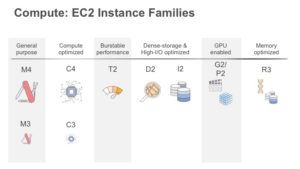Well I got through my checkride semi-successfully yesterday thanks for all of the well wishes. Today is election day so please get out to vote and execute your civic rights.
As for the topic of the blog, here is a high level intro to EC2 instance types. We will get deeper in the next post. EC2 is split into instance families as seen here.

Each family has it’s unique characteristics and as such its own use cases. Let’s go through some of these. The leading letter determines the family class, the following number indicates the generation of the instance, then the last part denotes the size of the instance. For example:
M4.XLarge = (M Family)(4th Generation) (Extra Large meaning 4 vCPU and 16 GB of mem)
The M class is a multi-purpose instance type, used for any number of applications where a balanced memory to cpu approach is applicable.
The C class is compute optimized and allows you to perform advanced network configuration and clustering of compute resources.
The T class is the default class and is highly burstable and the default instance type.
The D and I class are intended for database instances that users want to manage instead of using database services managed by AWS. The D class is dense storage while the I class is configured for large in memory databases like SAP HANA.
The G and P classes are for graphic intensive workloads. The G class has high performance NVIDIA processors for multimedia and high-end graphics, and the P class has GPU Direct support for general graphics workloads.
The R class is a memory optimized class that is meant for high memory hog apps think things like SharePoint.
For further comparison check out this chart, and the FAQ.
| Instance Type | vCPU | Memory (GiB) | Storage (GB) | Networking Performance | Physical Processor | Clock Speed (GHz) | Intel AVX† | Intel AVX2† | Intel Turbo | EBS OPT |
Enhanced Networking† |
| t2.nano | 1 | 0.5 | EBS Only | Low | Intel Xeon family | up to 3.3 | Yes | – | Yes | – | – |
| t2.micro | 1 | 1 | EBS Only | Low to Moderate | Intel Xeon family | Up to 3.3 | Yes | – | Yes | – | – |
| t2.small | 1 | 2 | EBS Only | Low to Moderate | Intel Xeon family | Up to 3.3 | Yes | – | Yes | – | – |
| t2.medium | 2 | 4 | EBS Only | Low to Moderate | Intel Xeon family | Up to 3.3 | Yes | – | Yes | – | – |
| t2.large | 2 | 8 | EBS Only | Low to Moderate | Intel Xeon family | Up to 3.0 | Yes | – | Yes | – | – |
| m4.large | 2 | 8 | EBS Only | Moderate | Intel Xeon E5-2676 v3** | 2.4 | Yes | Yes | Yes | Yes | Yes |
| m4.xlarge | 4 | 16 | EBS Only | High | Intel Xeon E5-2676 v3** | 2.4 | Yes | Yes | Yes | Yes | Yes |
| m4.2xlarge | 8 | 32 | EBS Only | High | Intel Xeon E5-2676 v3** | 2.4 | Yes | Yes | Yes | Yes | Yes |
| m4.4xlarge | 16 | 64 | EBS Only | High | Intel Xeon E5-2676 v3** | 2.4 | Yes | Yes | Yes | Yes | Yes |
| m4.10xlarge | 40 | 160 | EBS Only | 10 Gigabit | Intel Xeon E5-2676 v3 | 2.4 | Yes | Yes | Yes | Yes | Yes |
| m4.16xlarge | 64 | 256 | EBS Only | 20 Gigabit | Intel Xeon E5-2686 v4 | 2.3 | Yes | Yes | Yes | Yes | Yes |
| m3.medium | 1 | 3.75 | 1 x 4 SSD | Moderate | Intel Xeon E5-2670 v2* | 2.5 | Yes | – | Yes | – | – |
| m3.large | 2 | 7.5 | 1 x 32 SSD | Moderate | Intel Xeon E5-2670 v2* | 2.5 | Yes | – | Yes | – | – |
| m3.xlarge | 4 | 15 | 2 x 40 SSD | High | Intel Xeon E5-2670 v2* | 2.5 | Yes | – | Yes | Yes | – |
| m3.2xlarge | 8 | 30 | 2 x 80 SSD | High | Intel Xeon E5-2670 v2* | 2.5 | Yes | – | Yes | Yes | – |
| c4.large | 2 | 3.75 | EBS Only | Moderate | Intel Xeon E5-2666 v3 | 2.9 | Yes | Yes | Yes | Yes | Yes |
| c4.xlarge | 4 | 7.5 | EBS Only | High | Intel Xeon E5-2666 v3 | 2.9 | Yes | Yes | Yes | Yes | Yes |
| c4.2xlarge | 8 | 15 | EBS Only | High | Intel Xeon E5-2666 v3 | 2.9 | Yes | Yes | Yes | Yes | Yes |
| c4.4xlarge | 16 | 30 | EBS Only | High | Intel Xeon E5-2666 v3 | 2.9 | Yes | Yes | Yes | Yes | Yes |
| c4.8xlarge | 36 | 60 | EBS Only | 10 Gigabit | Intel Xeon E5-2666 v3 | 2.9 | Yes | Yes | Yes | Yes | Yes |
| c3.large | 2 | 3.75 | 2 x 16 SSD | Moderate | Intel Xeon E5-2680 v2 | 2.8 | Yes | – | Yes | – | Yes |
| c3.xlarge | 4 | 7.5 | 2 x 40 SSD | Moderate | Intel Xeon E5-2680 v2 | 2.8 | Yes | – | Yes | Yes | Yes |
| c3.2xlarge | 8 | 15 | 2 x 80 SSD | High | Intel Xeon E5-2680 v2 | 2.8 | Yes | – | Yes | Yes | Yes |
| c3.4xlarge | 16 | 30 | 2 x 160 SSD | High | Intel Xeon E5-2680 v2 | 2.8 | Yes | – | Yes | Yes | Yes |
| c3.8xlarge | 32 | 60 | 2 x 320 SSD | 10 Gigabit | Intel Xeon E5-2680 v2 | 2.8 | Yes | – | Yes | – | Yes |
| p2.xlarge | 4 | 61 | EBS Only | High | Intel Xeon E5-2686 v4 | 2.3 | Yes | Yes | Yes | Yes | Yes |
| p2.8xlarge | 32 | 488 | EBS Only | 10 Gigabit | Intel Xeon E5-2686 v4 | 2.3 | Yes | Yes | Yes | Yes | Yes |
| p2.16xlarge | 64 | 732 | EBS Only | 20 Gigabit | Intel Xeon E5-2686 v4 | 2.3 | Yes | Yes | Yes | Yes | Yes |
| g2.2xlarge | 8 | 15 | 1 x 60 SSD | High | Intel Xeon E5-2670 | 2.6 | Yes | – | Yes | Yes | – |
| g2.8xlarge | 32 | 60 | 2 x 120 SSD | 10 Gigabit | Intel Xeon E5-2670 | 2.6 | Yes | – | Yes | – | – |
| x1.16large | 64 | 976 | 1 x 1,920 SSD | 10 Gigabit | Intel Xeon E7-8880 v3 | 2.3 | Yes | Yes | Yes | Yes | Yes |
| x1.32xlarge | 128 | 1,952 | 2 x 1,920 SSD | 20 Gigabit | Intel Xeon E7-8880 v3 | 2.3 | Yes | Yes | Yes | Yes | Yes |
| r3.large | 2 | 15.25 | 1 x 32 SSD | Moderate | Intel Xeon E5-2670 v2 | 2.5 | Yes | – | Yes | – | Yes |
| r3.xlarge | 4 | 30.5 | 1 x 80 SSD | Moderate | Intel Xeon E5-2670 v2 | 2.5 | Yes | – | Yes | Yes | Yes |
| r3.2xlarge | 8 | 61 | 1 x 160 SSD | High | Intel Xeon E5-2670 v2 | 2.5 | Yes | – | Yes | Yes | Yes |
| r3.4xlarge | 16 | 122 | 1 x 320 SSD | High | Intel Xeon E5-2670 v2 | 2.5 | Yes | – | Yes | Yes | Yes |
| r3.8xlarge | 32 | 244 | 2 x 320 SSD | 10 Gigabit | Intel Xeon E5-2670 v2 | 2.5 | Yes | – | Yes | – | Yes |
| i2.xlarge | 4 | 30.5 | 1 x 800 SSD | Moderate | Intel Xeon E5-2670 v2 | 2.5 | Yes | – | Yes | Yes | Yes |
| i2.2xlarge | 8 | 61 | 2 x 800 SSD | High | Intel Xeon E5-2670 v2 | 2.5 | Yes | – | Yes | Yes | Yes |
| i2.4xlarge | 16 | 122 | 4 x 800 SSD | High | Intel Xeon E5-2670 v2 | 2.5 | Yes | – | Yes | Yes | Yes |
| i2.8xlarge | 32 | 244 | 8 x 800 SSD | 10 Gigabit | Intel Xeon E5-2670 v2 | 2.5 | Yes | – | Yes | – | Yes |
| d2.xlarge | 4 | 30.5 | 3 x 2000 | Moderate | Intel Xeon E5-2676 v3 | 2.4 | Yes | Yes | Yes | Yes | Yes |
| d2.2xlarge | 8 | 61 | 6 x 2000 | High | Intel Xeon E5-2676 v3 | 2.4 | Yes | Yes | Yes | Yes | Yes |
| d2.4xlarge | 16 | 122 | 12 x 2000 | High | Intel Xeon E5-2676 v3 | 2.4 | Yes | Yes | Yes | Yes | Yes |
| d2.8xlarge | 36 | 244 | 24 x 2000 | 10 Gigabit | Intel Xeon E5-2676 v3 | 2.4 | Yes | Yes | Yes | Yes | Yes |

 Today is my checkride at AWS. Essentially I will stand in-front of a panel of my peers and present the AWS 101 deck and be asked questions in a real world customer scenario. I wouldn’t say I am nervous but I am anxious to see if I am as far along as I need\hope to be. One of the things I expect to be covered in depth is direct connect (DX), so while I am prepping I figured I would write up a quick post on what DX is and how it works.
Today is my checkride at AWS. Essentially I will stand in-front of a panel of my peers and present the AWS 101 deck and be asked questions in a real world customer scenario. I wouldn’t say I am nervous but I am anxious to see if I am as far along as I need\hope to be. One of the things I expect to be covered in depth is direct connect (DX), so while I am prepping I figured I would write up a quick post on what DX is and how it works. Again it’s the weekend and no one is reading these posts anyway so I figured I would try my
Again it’s the weekend and no one is reading these posts anyway so I figured I would try my #1: Find something challenging
#1: Find something challenging #4: Work/Life Struggle
#4: Work/Life Struggle #5: Don’t rush
#5: Don’t rush